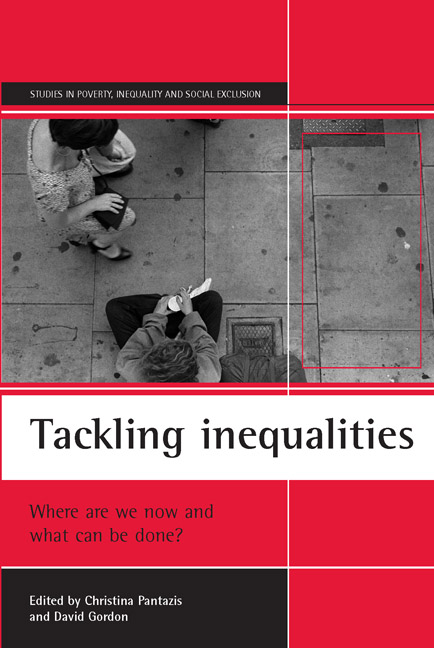Book contents
- Frontmatter
- Contents
- List of tables and figures
- Preface
- Acknowledgements
- List of acronyms
- Notes on contributors
- 1 Introduction
- 2 Inequalities in income, wealth and standard of living in Britain
- 3 Inequalities in employment: problems of spatial divergence
- 4 Educational inequalities and Education Action Zones
- 5 How can we end inequalities in housing?
- 6 Tackling inequalities in crime and social harm
- 7 Poverty across the life-course and health
- 8 Inequalities in health service provision: how research findings are ignored
- 9 A mortality league table for Cabinet ministers?
- 10 Ending world poverty in the 21st century
- Index
5 - How can we end inequalities in housing?
Published online by Cambridge University Press: 05 July 2022
- Frontmatter
- Contents
- List of tables and figures
- Preface
- Acknowledgements
- List of acronyms
- Notes on contributors
- 1 Introduction
- 2 Inequalities in income, wealth and standard of living in Britain
- 3 Inequalities in employment: problems of spatial divergence
- 4 Educational inequalities and Education Action Zones
- 5 How can we end inequalities in housing?
- 6 Tackling inequalities in crime and social harm
- 7 Poverty across the life-course and health
- 8 Inequalities in health service provision: how research findings are ignored
- 9 A mortality league table for Cabinet ministers?
- 10 Ending world poverty in the 21st century
- Index
Summary
Introduction
Housing is prominent in images of poverty, homelessness, poor health and poor education. Deprived estates and their problems of crime and unemployment have become increasingly important in debates about poverty (see Chapter Six) and the poverty and savings ‘traps’ are strongly affected by the operation of Housing Benefit and policies towards rents. In spite of this, housing has been nowhere near the top of the policy agenda and has increasingly been seen as part of the problem rather than a solution. During the last 20 years, the housing policy agenda has actively operated to increase inequality. The promotion of home ownership and the changed financial regime for social rented housing have contributed to an increasing concentration of lower income groups in council and housing association property. The residualisation of these tenures and the active deregulation of the private-rented sector have left a more unequal housing system. This is reflected in the increased spatial concentration of deprived households living in cities and towns.
At the end of the 1990s, there is some renewed interest in housing issues. While housing itself is not at the top of the agenda, the concerns about health and education have increasingly identified housing as a key element affecting demand and performance in these areas. At the same time, policies to get people into the labour market and expand employability, increasingly come up against the issue of residualised housing. Housing itself has not been at the top of the policy agenda of the Labour government but it has an important place in the emerging discussion of social exclusion. Two of the three initial priorities identified for the Social Exclusion Unit, following its creation in December 1997, relate to housing: rough sleepers and the worst estates. The recognition of housing's past is a welcome development. However, this chapter will argue that the nature of the response is insufficient and that it could be inappropriate.
Background
The traditional debate about housing inequality focused on a series of circumstances which threatened life chances: unfitness, overcrowding, sharing, and a lack of amenities. These circumstances have by no means been eliminated. However, enormous progress was made in the three decades after 1946 in reducing the number of households and dwellings affected by such circumstances. Tables 5.1 and 5.2 set out the key statistics related to the conventional measures of housing problems and housing shortage at a national level.
- Type
- Chapter
- Information
- Tackling InequalitiesWhere Are We Now and What Can Be Done?, pp. 101 - 116Publisher: Bristol University PressPrint publication year: 2000



